Birds in Science
Scientists have successfully tested their ability to identify and DNA "barcode" entire assemblages of species -- the prelude to a genetic portrait of all animal life on Earth (original article). They report having assembled a genetic portrait of birdlife in the U.S. and Canada, and announce the startling discovery of 15 new genetically distinct species, nearly indistinguishable to human eyes and ears and consequently overlooked in centuries of bird studies. The bird researchers obtained DNA from "voucher" specimens in museums, augmented by samples sent in by scores of people. In all, more than 2,500 specimens were barcoded. The DNA portrait of 643 bird species, from the Arctic tundra to the temperate woodlands to the Florida Keys, represents 93 percent of 690 known breeding species in the U.S. and Canada. Work continues to collect DNA of the remaining 47 listed North American species, as well as several more considered extinct, specimens of which exist in museums. GrrlScientist note: Even though I am a molecular biologist, I think that this report makes the data appear to be more significant than it really is. For example, considering the huge differences in plumage and beak morphology between male blue-winged and cinnamon teal, my guess is these dramatic differences are in place for a reason: female choice. And isn't behavior important when defining species? In my opinion, these data are better for suggesting species splits than species lumping.
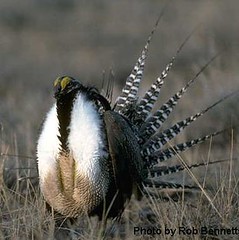 The male greater sage-grouse, Centrocercus urophasianus (pictured, Image Rob Bennet/USDA), a chicken-like game bird, isn't too picky about mates. Researchers have observed the bird trying to woo unusual objects -- even cow patties in the field. So perhaps it's no surprise that these males are fooled by UC Davis researcher Gail Patricelli's bird robot, which is fairly convincing despite the wheels instead of legs. Patricelli is using the feathered fembot to learn about mating rituals of the greater sage-grouse. She tested a prototype in Wyoming last year and will return this spring to put the cyber chick to the test. Patricelli, an assistant professor in UCD's section of evolution and ecology, was interviewed by a New York film crew Thursday for an episode of television show "NATURE" slated to air on PBS in spring 2008. The show, tentatively titled "Sexual Selection," is being developed as a two-part series by Thirteen/WNET New York's NATURE and Pangolin Pictures. "It's exciting. It's always fun," Patricelli said of the filming. "We do all this research and publish it in professional journals. It's nice to get the word out and let people know about it (outside of academia)."
The male greater sage-grouse, Centrocercus urophasianus (pictured, Image Rob Bennet/USDA), a chicken-like game bird, isn't too picky about mates. Researchers have observed the bird trying to woo unusual objects -- even cow patties in the field. So perhaps it's no surprise that these males are fooled by UC Davis researcher Gail Patricelli's bird robot, which is fairly convincing despite the wheels instead of legs. Patricelli is using the feathered fembot to learn about mating rituals of the greater sage-grouse. She tested a prototype in Wyoming last year and will return this spring to put the cyber chick to the test. Patricelli, an assistant professor in UCD's section of evolution and ecology, was interviewed by a New York film crew Thursday for an episode of television show "NATURE" slated to air on PBS in spring 2008. The show, tentatively titled "Sexual Selection," is being developed as a two-part series by Thirteen/WNET New York's NATURE and Pangolin Pictures. "It's exciting. It's always fun," Patricelli said of the filming. "We do all this research and publish it in professional journals. It's nice to get the word out and let people know about it (outside of academia)."
People Helping Birds
 Nature Canada (BirdLife in Canada) has applauded the move by the federal government of Canada to settle an outstanding court case that surrounds the protection of the Piping Plover, Charadrius melodus (pictured, Image: USFWS). The move could be the first step towards enhanced protection for many of Canada's other endangered species, say conservationists. "For naturalists, the court case was a last resort that we saw as a choice between doing nothing and risking extinction of not just the plovers, but also Canada's endangered species protection law," said Julie Gelfand, President of Nature Canada.
Nature Canada (BirdLife in Canada) has applauded the move by the federal government of Canada to settle an outstanding court case that surrounds the protection of the Piping Plover, Charadrius melodus (pictured, Image: USFWS). The move could be the first step towards enhanced protection for many of Canada's other endangered species, say conservationists. "For naturalists, the court case was a last resort that we saw as a choice between doing nothing and risking extinction of not just the plovers, but also Canada's endangered species protection law," said Julie Gelfand, President of Nature Canada.
Nine endangered Puaiohi birds also known as the Small Kauai Thrush, Myadestes palmeri, raised in captivity will be set free in Kauai's remote Alakai Wilderness this weekend. Handlers say the small gray-brown birds will face their toughest days as they fly off into the rain-soaked ohia forest. The puaiohi are a success story among the 35 threatened or endangered native Hawaiian bird species. There are about 300 to 600 puaiohi on Kauai, the only place they have ever been found. Conservation biologists have released 132 of the birds into the wild since 1999.
Robins are supposed to be harbingers of spring.But lacking food and weakened by cold, they have become casualties of winter. They're dying by the dozens along Muirfield Drive in Dublin. "They were lulled into thinking it was warm, so they stayed," said Mike Seidel, education program coordinator at the center. "They were so compromised so quickly, so they could not possibly evacuate." Local songbirds such as robins and cedar waxwings feed on berries and worms, said veterinarian Don Burton, director of the Ohio Wildlife Center. But snow cover and bitter cold mean no worms and dwindling supplies of berries such as crab apples. In addition to starvation, cars are hitting the birds as the weakened creatures cross Muirfield Drive to get at crab apple trees in the median. They're also sunning themselves on the relatively warm pavement.
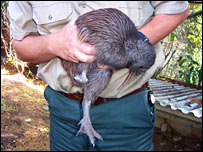 The Wellington Zoo has created a special encounter area in the entrance to its nocturnal house where Tahi, the one-legged Kiwi, Apteryx mantelli (pictured, Image: BBC news), can be seen foraging for worms. Tahi was found caught by the leg in a trap near Wanganui more than a year ago. Vets at Massey University in Palmerston North could not save his leg. The zoo then asked Weta Workshop and the Artificial Limb Centre to make the three-year-old bird a prosthesis. It worked well but he seemed to be uncomfortable where it joined his stump, so it was decided he was better off without it. He now hops, using his stump to swing his weight forward. "He's got really used to it," zoo spokeswoman Beth Houston said.
The Wellington Zoo has created a special encounter area in the entrance to its nocturnal house where Tahi, the one-legged Kiwi, Apteryx mantelli (pictured, Image: BBC news), can be seen foraging for worms. Tahi was found caught by the leg in a trap near Wanganui more than a year ago. Vets at Massey University in Palmerston North could not save his leg. The zoo then asked Weta Workshop and the Artificial Limb Centre to make the three-year-old bird a prosthesis. It worked well but he seemed to be uncomfortable where it joined his stump, so it was decided he was better off without it. He now hops, using his stump to swing his weight forward. "He's got really used to it," zoo spokeswoman Beth Houston said.
People Hurting Birds
Pressure continues to be put on the government of Grenada and the Four Seasons Hotel Group by conservationists worldwide, after proposed plans to build a large-scale resort on one of the last remaining habitats for Grenada Dove, Leptotila wellsi, appear to continue unabated. The Mount Hartman National Park -- coined the 'Dove Sanctuary' -- is to be sold to make way for the Four Seasons Resort. The National Park holds 22% of the global population of this Critically Endangered bird - equating to just 20 pairs. Since news of the potential sale of the park was announced a number of ornithologists, conservation organisations and high-profile supporters have lent their voice to the campaign, putting forward arguments against the sale and condemning the government of Grenada and Four Seasons for what are deemed by many to be "irresponsible" actions.
Some might think unsightly bird doo is the least of the NYC subway's smelly problems. But nevertheless, the Metropolitan Transportation Authority will show those fowl who's boss with Operation Bird-B-Gone, a mission to be executed at three of the most pooed on stations on the no. 7 line. What's the master plan? To keep birds from reproducing underground and, inevitably, defecating, birds will be zapped when they go to roost on ledges in the stations. Beware of falling pigeons. The New York Sun reports: "Today, the MTA and state representatives will announce the completion of station refurbishments, including the electrical wiring, at the 103rd street station. The MTA will next tackle the pigeon woes at the 90th Street station."
Birds and Airplanes
A bird sucked into an engine delayed the departure of an Emirates airline flight from Kolkata, India, to Dubai for more than four hours yesterday, an airline spokesperson said. Passengers said the flight EK 547 took off at around 1.25pm. "We were told there is a technical snag," said a journalist returning to Dubai after her brief holiday. The flight was originally slated to depart at 8.55am.
Endangered Birds
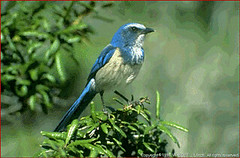 U.S. Fish & Wildlife updated its Florida scrub-jay, Aphelocoma coerulescens (pictured, Image: Birding), zoning practices last year, and the county updated its Web site to reflect that policy on Wednesday. One woman just found out the new policy means she can't build on her property. Environmental advocates say the new plan could further endanger the protected bird. New criteria used in practice by U.S. Fish & Wildlife to determine scrub-jay zones has taken 3,200 lots off the rolls, making them eligible to be built on. With the new method, if a scrub-jay is spotted on a property, a radius of 850 feet is drawn around that spot, and all of the land is considered protected. But the new practice has also captured some lots, making them essentially worthless on the open market. "Now I can't get rid of mine, I can't sell mine, and my sister can't build," said Eunice Colacino.
U.S. Fish & Wildlife updated its Florida scrub-jay, Aphelocoma coerulescens (pictured, Image: Birding), zoning practices last year, and the county updated its Web site to reflect that policy on Wednesday. One woman just found out the new policy means she can't build on her property. Environmental advocates say the new plan could further endanger the protected bird. New criteria used in practice by U.S. Fish & Wildlife to determine scrub-jay zones has taken 3,200 lots off the rolls, making them eligible to be built on. With the new method, if a scrub-jay is spotted on a property, a radius of 850 feet is drawn around that spot, and all of the land is considered protected. But the new practice has also captured some lots, making them essentially worthless on the open market. "Now I can't get rid of mine, I can't sell mine, and my sister can't build," said Eunice Colacino.
The rare and endangered White-bellied heron, Ardea insignis, spotted mainly along the Pochhu river in Punakha, Bhutan, might, after all, have a protected habitat for itself. The proposal submitted by the National Environment Commission (NEC) to the Council of Cabinet Ministers (CCM) to shut down some of the sand and stone quarries along the Pochhu river to protect heron habitat was approved in principle. NEC deputy minister, Dasho Nado Rinchhen said that the government would have to strike a deal with the contractor to stop lifting the remaining quarry. "Although there is loss of revenue for stopping sand and boulders from being lifted, we could generate something equivalent through bird watching," he said.
Parrot News
The Australian has learned that National Parks and Wildlife Service officers have found a dead night parrot, Geopsittacus occidentalis, in the country's far west, confirming the survival of Australia's rarest bird. In a discovery of international significance, the parrot was found in November in the Diamantina Lakes region after it flew into a barbed-wire fence. The Government has kept the find secret to avoid birdwatchers searching for night parrots while it does a survey to find more. A road-killed night parrot found in 1990 near Boulia, in northwest Queensland, by Australian Museum scientists was the first confirmed record of the species since 1912. That find forced millionaire businessman Dick Smith to part with a $50,000 reward he had offered for evidence that it existed.
As Australian bird watchers debate the existence of the so-called blue-fronted fig parrot, Kowald, 75, is kicking himself that the dead parrot he picked up was probably eaten by a cat. "I saw the picture in [the] Courier-Mail and I'm absolutely positive that's the bird I saw," he said yesterday. "It was spot-on." Kowald, who lives north of Elimbah, near Caboolture, said: "Six or eight months ago, I was in my shed and one of these parrots hit the window and killed itself. "I didn't blinking realise it was an unrecognised type of bird. I asked quite a few people around here what it was. I would have put it in the freezer if I'd known how important it was. In the end, I put it on a rail, dead, and a cat must have taken it."
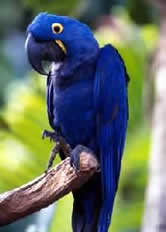 She was angry, belligerent, mistrusting of males. He was lonely, balding and unlucky in love. Thrown together by fate, sparks flew. Maybe referring to the hyacinth macaws, Anodorhynchus hyacinthinus (pictured, Image: WWF), at Riverbanks Zoo as lovebirds is reading too much into the situation, but two years after their first meeting, they are the protective parents of a rare hatchling. "Sometimes we take for granted when you have a male and a female together that things are going to work out," said Ted Fox, curator of birds at the Rosamond Gifford Zoo in Syracuse, N.Y. But with birds, just as with people, arranged marriages don't always work.
She was angry, belligerent, mistrusting of males. He was lonely, balding and unlucky in love. Thrown together by fate, sparks flew. Maybe referring to the hyacinth macaws, Anodorhynchus hyacinthinus (pictured, Image: WWF), at Riverbanks Zoo as lovebirds is reading too much into the situation, but two years after their first meeting, they are the protective parents of a rare hatchling. "Sometimes we take for granted when you have a male and a female together that things are going to work out," said Ted Fox, curator of birds at the Rosamond Gifford Zoo in Syracuse, N.Y. But with birds, just as with people, arranged marriages don't always work.
A sick parrot has saved the lives of a family who were succumbing to the effects of carbon monoxide. When the family of three awoke feeling unwell on Saturday morning, they decided to return to bed. However, when they noticed that their 10-year-old cockatoo Georgie had been sick they realised something was seriously wrong. The family, from Dalgety Bay, in Fife, UK, called the emergency services and collapsed just as an ambulance arrived. "I thought he [the parrot] might have choked on a pecan nut, so I made sure he had brought everything up. The next minute I began to shake," said the mother. "When my husband came back in to the bedroom he began to realise something was seriously wrong."
Avian Influenza
When the H5N1 bird flu outbreak was identified at the Bernard Matthews turkey production complex in Suffolk, following an outbreak in Hungarian poultry farms, some pointed the finger of blame at wild birds. Presumably, a kamikaze duck had plunged head-first down a ventilation shaft into the sealed hangars containing turkeys. Wild birds have long been blamed in South-East Asia, where H5N1 is now endemic in the poultry industry. In July 2004, the Thai Prime Minister Thaksin Shinawatra called for wild openbill storks, Anastomus oscitans, to be slaughtered when H5N1 broke out in Thailand's poultry farms. The storks' death sentence was only lifted when conservation group Birdlife International intervened. "It is BirdLife's view that the authorities must work harder to present a balanced picture, and not allow automatic implication of wild birds as the likeliest vector every time an outbreak occurs," said A spokesman for BirdLife. "Even without additional evidence, the circumstances in these cases should have strongly suggested that other means of transmission were more likely." GrrlScientist note: This is what I have been saying for years and years now. It's about time that governments started to pay attention to ornithologists instead of epidemiologists when seeking information about wild birds.
Indonesia finally agreed on Friday to resume sharing samples of the deadly bird flu virus with the World Health Organisation, but only after steps were taken to ensure developing countries get fair and equitable access to vaccines. The U-turn by the country worst affected by the H5N1 virus came after five hours of negotiations in Jakarta with David Heymann, the WHO's chief of communicable diseases. Once sharing resumes, researchers should be able to see if the Indonesian strain of H5N1 has mutated into a form that makes human-to-human transmission more likely.
The World Health Organization (WHO) confirmed a fatal H5N1 avian influenza case in a 37-year-old woman in Egypt, as the country's health ministry announced that a 5-year-old boy had tested positive for the virus. Egyptian officials announced the case in the woman, from Fayyoum governorate about 60 miles south of Cairo, 2 days ago. The WHO, in a statement confirming her illness as the country's 21st case, said she was hospitalized Feb 12 and had helped slaughter and defeather sick birds a week before she became ill. She is the 13th Egyptian to die of the virus and the third in 2007.
The H5N1 strain of bird flu has killed poultry in the Moscow region for the first time, Russia's chief sanitary expert and head of a consumer watchdog was quoted by RIA news agency as saying. "The pathogenicity of this virus for people has not been confirmed. Vets have detected it; they confirm it is the H5N1 strain," Gennady Onishchenko said. Last month Russia recorded its first cases this year of the H5N1 strain in dead domestic birds, detected in the southern Krasnodar region.
Ivory Coast has stepped up its surveillance of poultry to detect possible outbreaks of avian influenza following the death of a Nigerian woman who contracted the illness last month. As part of Côte d'Ivoire's measures, thousands of agents from the government's committee to fight bird flu have been deployed to assess the situation, said Alphonse Douaty, minister of Animal Production and Marine Resources. In addition, he said, the bird flu fight is being decentralised to facilitate communication.
At least a million domestic birds will be vaccinated against avian influenza near Moscow, Russia now that the disease has reached areas surrounding the Russian capital, a senior local veterinary official said Monday. "All the birds will be vaccinated for free," Olga Gavrilenko, head of the local department of Russia's veterinary watchdog, said after a deadly virus of bird flu was registered in five districts of the Moscow Region at the weekend. All poultry in the region is normally inoculated twice a year, in spring and in fall. But in view of the current epidemic, experts have recommended that all the birds be immunized again.
Streaming Birds
 This week on BirdNote, for the week of February 19, 2007: Monday and Tuesday, the Northern Spotted Owl, Strix occidentalis caurina; Wednesday, color morphs of the Northern Fulmar, Fulmarus glacialis; Thursday, the Winter Wren, Troglodytes troglodytes (pictured, top); Friday, the Japanese legend of "The Crane-wife". BirdNotes transport the listener out of the daily grind with two-minute vignettes that incorporate the rich sounds of birds provided by Cornell University and by other sound recordists, with photographs and written stories that illustrate the interesting -- and in some cases, truly amazing -- abilities of birds. Some of the shows are Pacific Northwest-oriented, but many are of general interest. BirdNote can be heard live, Monday through Friday, 8:58-9:00AM in Western Washington state and Southern British Columbia, Canada, on KPLU radio and now also in North Central Washington state on KOHO radio. All episodes are available in the BirdNote archives, both in written transcript and mp3 formats, along with photographs. Listener ideas and comments are welcomed. [rss].
This week on BirdNote, for the week of February 19, 2007: Monday and Tuesday, the Northern Spotted Owl, Strix occidentalis caurina; Wednesday, color morphs of the Northern Fulmar, Fulmarus glacialis; Thursday, the Winter Wren, Troglodytes troglodytes (pictured, top); Friday, the Japanese legend of "The Crane-wife". BirdNotes transport the listener out of the daily grind with two-minute vignettes that incorporate the rich sounds of birds provided by Cornell University and by other sound recordists, with photographs and written stories that illustrate the interesting -- and in some cases, truly amazing -- abilities of birds. Some of the shows are Pacific Northwest-oriented, but many are of general interest. BirdNote can be heard live, Monday through Friday, 8:58-9:00AM in Western Washington state and Southern British Columbia, Canada, on KPLU radio and now also in North Central Washington state on KOHO radio. All episodes are available in the BirdNote archives, both in written transcript and mp3 formats, along with photographs. Listener ideas and comments are welcomed. [rss].
Miscellaneous Birds
A Japanese whaling ship crippled by fire drifted off the world's largest penguin breeding grounds, and New Zealand alerted other countries it may need help if the vessel leaked oil into the pristine Antarctic waters. A Japanese fisheries official said that the blaze could force an early end to the season's whale hunt. One crewmember was missing from the 8,000-ton Nisshin Maru, which had started to list from water pumped aboard to fight the fire. The fire was contained below decks but continued to burn, said New Zealand Conservation Minister Chris Carter. No oil had spilled and the vessel was in no immediate danger of sinking, officials said.
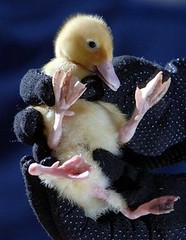 Webbed feet run in Stumpy's family, but he's the first to have four of them. A rare mutation has left the eight-day-old duckling with two nearly full-sized legs behind the two he runs on. Nicky Janaway, a duck farmer in New Forest, Hampshire, 95 miles southwest of London, showed the duckling to reporters Saturday. Stumpy would probably not survive in the wild, but Janaway, who runs the Warrawee Duck Farm in New Forest, says he is doing well. "He's eating and surviving so far, and he is running about with those extra legs acting like stabilizers," Janaway said.
Webbed feet run in Stumpy's family, but he's the first to have four of them. A rare mutation has left the eight-day-old duckling with two nearly full-sized legs behind the two he runs on. Nicky Janaway, a duck farmer in New Forest, Hampshire, 95 miles southwest of London, showed the duckling to reporters Saturday. Stumpy would probably not survive in the wild, but Janaway, who runs the Warrawee Duck Farm in New Forest, says he is doing well. "He's eating and surviving so far, and he is running about with those extra legs acting like stabilizers," Janaway said.
.
The Fine Print: Thanks to Mike, Biosparite, Ian, Diane, Jeremy, Ellen and Ron for sending story links. Thanks in advance to Ian for catching my typos; as you probably know by now, I put a few typographical errors in these documents just so Ian can find them! The featured image appears here with the kind permission of the photographer, so please contact him if you also wish to purchase this or other of his images. Other images are resized and are either linked from the news story that they accompany or they are credited and linked back to the photographer.
What is the point of Birds in the News? I publish BITN each week because I want to increase people's awareness of the importance of birds in our everyday lives. Birds represent many things to us; beauty, freedom, music, wildness. But everywhere, birds are coming under increasing pressure for their very survival, and by linking to news stories about birds, I hope to make the smallest impression upon the public and the mainstream media, as well as our decision-makers, that birds are an important feature of our everyday lives, that there are so many reasons that we could not do without them.
tags: Birds in the News, ornithology, birds, avian, newsletter



i love the fembot line, and "...Researchers have observed the bird trying to woo unusual objects -- even cow patties in the field..."
sounds like any texas bar after hours... :)
I love that you're doing these birdy compilations & news notes again! And I have a pretty good idea of all the labor (of love) that goes into their production. Many thanks!
Thanks so much for all your hard work- I'm glad the news notes are back! I have a pic for what I believe is the cutest bird alive.... I'll send it to you.
Greenpeace has offered to use their ship to tow the crippled whaling ship to port, but the whaling company turned them down.
http://www.enn.com/today.html?id=12243
Pigeons sometimes get onto the #7 train. Except for the first and last couple of stops the line is elevated and the trains open to the outdoors. The MTA is probably annoyed because the pigeons are turnstile jumpers.
ahhhh, another "fix" for the week of wonderful birdie news! Here is a link for more on Gail Patricelli's webpage about her work: http://www.eve.ucdavis.edu/gpatricelli/Patricelli_Research_Interests.ht…
BITN is one of my favorite weekly events. I noticed the winter wren has a generic and species name of "Troglodytes." How in the world did that happen? I have to deal with human-style troglodytes virtually on a daily basis, and they don't remind me of a wren. A chimp is Pan troglodytes, and no self-respecting wren would wish to be compared to a chimp.
The robin crisis in Dublin may be a special case. I have seen large flocks of robins wintering over in the woods around the campus of Hollins College near Roanoke, Virginia in late December 2003 and 2005. The snow and cold don't seem to compromise them. So is Dublin short of potential food sources such as berries from bushes used in landscaping? It would be interesting to delve into that a bit further.
As a matter of local interest, Tinker Creek, as in PILGRIM AT TINKER CREEK by Annie Dillard, flows through the woods adjacent to the campus. I would recommend the book to anyone who has not had the pleasure of reading it.